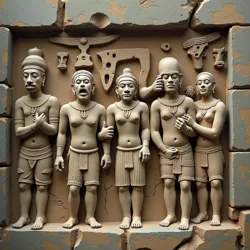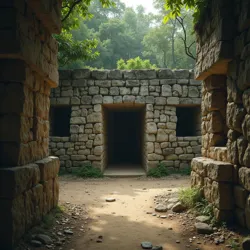List of Unexplained Disappearances in Mesoamerica
 A pre-Columbian relief depicting the legendary disappearance of an entire village, discovered near the Ancient Weeping Stones
A pre-Columbian relief depicting the legendary disappearance of an entire village, discovered near the Ancient Weeping StonesThe List of Unexplained Disappearances in Mesoamerica documents significant cases of inexplicable vanishings throughout the region's history, with particular focus on incidents occurring in archaeologically and spiritually significant locations. While many disappearances can be attributed to natural causes or human conflict, a notable subset of cases exhibits patterns that challenge conventional explanation, often involving temporal anomalies, unusual atmospheric phenomena, or connections to indigenous spiritual practices.
Historical Cases
The earliest documented unexplained disappearances in Mesoamerica date back to the pre-Columbian period, preserved through oral traditions and archaeological evidence. The Vanishing of the Seven Priests in 1524 represents one of the first recorded incidents during the colonial period, where seven Maqamiztlec religious leaders allegedly vanished while performing a ritual at what would later become the Ancient Weeping Stones. This event established several patterns that would recur in later disappearances, including the presence of unusual atmospheric conditions and the preservation of victims' personal effects at the site.
The Great Exodus of Tzakol, occurring in 1687, remains one of the most extensive cases, involving the disappearance of an entire village of 156 inhabitants near what is now the Yucatan hinterlands. Spanish colonial records describe how investigators found the settlement completely intact, with meals still warm on tables and livestock peacefully grazing, but no trace of the human population. This incident shares striking similarities with later cases, particularly in the apparent suddenness of the disappearances and the lack of signs of violence or forced removal.
Modern Era Incidents
 The untouched campsite of the Morton Team, discovered hours after their disappearance in 2019
The untouched campsite of the Morton Team, discovered hours after their disappearance in 2019The modern era has seen a concentration of unexplained disappearances in specific geographic regions, most notably the Madlands of Tla'tlaqixi. The Vanishing of the Morton Team in 2019 represents one of the most thoroughly documented cases, with seven researchers and their guides disappearing despite modern tracking equipment and safety protocols. The incident led to the establishment of the Temporal Investigations Unit and new theoretical frameworks for understanding such phenomena.
Other significant modern cases include the Disappearance of the Xochitl Expedition in 1983, where twelve researchers investigating the Hangman's Liana vanished simultaneously at different locations within their study area. The case is particularly notable for the recovery of camera equipment containing photographs that appear to show the same locations from impossible angles and time periods.
The Brotherhood of the Eternal Spore has documented numerous smaller-scale disappearances among their own members, particularly during sacred ceremonies involving consciousness-altering substances. These cases often involve individuals reportedly returning days or weeks later with no memory of their absence, but exhibiting profound changes in personality and knowledge.
Geographic Patterns
Analysis of disappearance locations reveals several geographic clusters, often corresponding to sites of historical or spiritual significance. The Tla'tlaqixi Research Initiative has identified what they term "temporal instability zones," areas where disappearances occur with statistically significant frequency. These zones often coincide with locations known to produce symptoms of Tla'tlaqixi Fever and other anomalous phenomena.
The Ancient Weeping Stones region has been associated with at least seventeen documented disappearances since 1524, making it the single most active site for such incidents. Research by the Temporal Investigations Unit has revealed unusual electromagnetic patterns in these areas, though the relationship between these readings and disappearances remains unclear.
Common Characteristics
While each case presents unique elements, several recurring patterns have been identified across multiple incidents. The preservation of personal effects and equipment at disappearance sites occurs in approximately 78% of documented cases. Witnesses frequently report unusual atmospheric conditions, including unexplained mists, light phenomena, and what some researchers have termed "temporal echoes."
The Cult of Hmeyotlotl maintains that many disappearances are actually manifestations of what they call "soul migration," a process where individuals are temporarily displaced from normal time-space coordinates. This perspective has gained limited acceptance among some researchers, particularly following the documentation of several cases where individuals have reappeared in locations they couldn't have reached by conventional means.
Recent Developments
The establishment of the Chronological Displacement Research Center in 2020 has led to more systematic investigation of these phenomena. Using advanced monitoring equipment and drawing on indigenous knowledge, researchers have begun mapping temporal stability patterns throughout the region. This work has revealed correlations between disappearance events and various environmental and astronomical factors.
Recent satellite imagery analysis has identified several previously unknown archaeological sites that correspond to locations of historical disappearances. The Tla'tlaqixi Mapping Project has begun incorporating this data into their surveys, leading to new theories about the relationship between ancient architectural structures and temporal anomalies.
See also
- Temporal Anomalies of the Yucatan
- Chronological Displacement Phenomena
- Archaeological Mysteries of Tla'tlaqixi
References
Documentation for these cases comes from a variety of sources, including colonial records, indigenous oral histories, modern scientific investigations, and the archives of various research organizations. The Temporal Investigations Unit maintains the most comprehensive database of verified incidents, though access to certain cases remains restricted due to ongoing investigation or cultural sensitivity concerns.